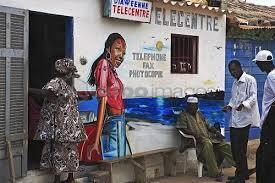This post was written by David Townsend. For more on public access and its role in healthy broadband markets, stay tuned for the release of the 2019 Affordability Report on October 22, 2019.

Throughout the history of technology innovation and evolution, public access facilities have always been a key feature of the landscape. In the earliest eras of electronic wired and wireless networks, users typically obtained service only at public stations, such as telegraph offices and radio messaging and calling stations, whether at municipal call centers or on board ships at sea. Even long after private telephone service became available, public telephones remained a central feature of societal communication. Cities throughout the world were densely populated with coin-operated public phone booths, along with countless public call boxes for emergency connections to police and fire stations.

As private telephone service became more ubiquitous globally, public call centers continued to be found: locations with one or multiple phones, managed by a local shop owner or small entrepreneur, which allowed customers to place calls for a fee, often the only option for many users, especially for long-distance and international calls.
Most of the focus of public telephone access was initially concentrated in urban and higher population areas. By the mid-1990s, early Universal Service Fund (USF) programs began to identify public telephone service as a means to bring electronic communication to remote, isolated communities. Often these programs funded installation of satellite-based public pay phones in these areas. Some of the first USFs were established in Latin America (Colombia, Peru, Chile), and in Southeast Asia (Thailand, Indonesia) were of this type.
Following the rapid growth of cellular mobile telephone services starting in the late 1990s, the public access model continued to thrive in parts of the developing world, adapting to new technologies. As mobile phone demand grew, those who could not readily afford these services sometimes developed a “public” option in the form of sharing of mobile phones. The Grameen Phone initiative in Bangladesh provided microcredit loans, typically to selected women entrepreneurs, to allow them to purchase a mobile phone and airtime, to resell at a modest price markup to neighbors. The program was very successful, and Grameen Phone evolved to become a prominent and profitable operator in Bangladesh. Similar initiatives took place on an informal basis in many countries. Bolivia, for example, was well known for the proliferation of “phone ladies” offering voice calling services in public markets.
Access to Information and Social Networking
Similar observations can be made about the history of public information access facilities, and the evolution of what is today classified as “social networking.” The oldest and most respected tradition of this nature is the public library, which dates from the ancient world as a location where information and knowledge are stored and can be accessed by scholars and common citizens alike. While libraries traditionally stored books and other printed material, they have recently evolved in many locations to offer digital media and Internet and Wifi connections, in keeping with their mission.
An equally ancient institution is the postal service. Sending written letters through the old-fashioned public mail was the original form of social networking, a practice that is all but extinct in the era of electronic communications. Parallels can also be seen between the short-message and photo sharing phenomena of Facebook, Twitter, and Instagram and the once flourishing popularity of picture postcards. These habits required people to visit public post office buildings, which also became social gathering spots in many towns and villages. Other forms of public communication at post offices often included everything from bulletin boards – where the public could post messages and personal advertisements – to telegraph stations and, nowadays, computers with internet access.
In many communities, other public facilities have also served as socialization and information sharing centers. Public schools and community centers are locations for meetings, notices and announcements, and social events, and repositories of local information and documents. Government offices, especially in smaller towns, serve many of the same functions.
More generally, the entire radio and television broadcasting industry in most countries developed along the lines of “free” access to transmission signals, supported either by government funds and/or commercial advertising.
Throughout traditional societies, all of these types of venues have operated as de facto public resources for social information and communications. It is a natural human habit to gather in a central location, to talk, to read and research, and to exchange correspondence of one kind or another.
Public access facilities have always been a key feature of the traditional telecommunications landscape, since the earliest eras of electronic wired and wireless networks. Public telegraph offices, radio messaging stations, and telephone booths were commonplace before the modern technology era, and free public radio and TV broadcasting remain an important source of information and entertainment. Post offices and public libraries have also traditionally served as public locations for exchanging messages and accessing information.
Following the revolutionary arrival of the Internet in 1995, Internet access in many areas was often available only through business or government offices, and on some university campuses, with very few households owning computers, and even fewer having dial-up Internet service. This was especially the case in most developing countries. In this environment, by the late 1990s, a movement toward public Internet access began to emerge.
In some areas, usually in urban settings, a market arose for private commercial Internet cafés, where customers could purchase time to use a personal computer and an online connection. These were often small, one computer setups, in many cases an expansion of existing public telephone call centers. Such public Internet centers grew in popularity with the introduction of instant messaging and Voice over Internet Protocol (VOIP) applications, which allowed for real-time conversations between users anywhere in the world for a tiny fraction of the price of standard phone calls. The arrival of social networking media further reinforced this market. Young people in particular became regular users of public internet cafes in developing societies throughout the world.
Meanwhile, government policies also began to focus on establishing public ICT access facilities, to make such services available on an affordable basis beyond the scope of commercial internet cafés. One of the first such programs was established in Hungary in the mid-1990s, where a private, cooperative group established some pioneering “Telehaus” (tele-cottage) facilities in a few towns. The idea proved so popular that it soon caught on in neighboring countries and in other parts of the world. An ambitious early national telecenter program was set up in South Africa in the late 1990s, with an objective of creating hundreds of such ICT access centers throughout the country.
By the mid- 2000s, telecenter/ICT Access Center programs were introduced in many developing societies, as the goal of expanding internet access became a growing priority. These facilities took a variety of forms and included offering computers and Internet access in established public locations, such as post offices, libraries, government offices, and schools. The more ambitious programs supported construction and operation of stand-alone multipurpose community telecenters, sometimes with large facilities offering dozens of PC stations, ICT training, e-government and ecommerce support, and many other services. An international cooperation organization was even established, the Telecentre.org Foundation, information, advice, and a forum for sharing experiences and ideas among public ICT access advocates around the world.
Most recently, the notion of public internet access has expanded further, beyond physical facilities, to encompass provision of free or low-cost public Wifi access, through various government and cooperative platforms. Such services may be offered in open areas of cities and towns such as parks and community spaces; in government buildings and complexes; in transportation hubs such as bus stations and airports; or even across wider landscapes, with mesh Wifi networks deployed to cover a majority of public and even private lands. At the same time, commercial public Wifi offerings, akin to the market for Internet cafés, have begun to proliferate as well, with subscription-based or free hotspots increasingly available as an added feature in coffee shops, restaurants, shopping malls, and many other public spaces.
Public access facilities have always been a key feature of the traditional telecommunications landscape, since the earliest eras of electronic wired and wireless networks. Public telegraph offices, radio messaging stations, and telephone booths were commonplace before the modern technology era, and free public radio and TV broadcasting remain an important source of information and entertainment. Post offices and public libraries have also traditionally served as public locations for exchanging messages and accessing information.
Following the revolutionary arrival of the Internet in1995, Internet access in many areas was often available only through business or government offices, and on some university campuses, with very few households owning computers, and even fewer having dial-up Internet service. This was especially the case in most developing countries. In this environment, by the late 1990s, a movement toward public Internet access began to emerge.
In some areas, usually in urban settings, a market arose for private commercial Internet cafés, where customers could purchase time to use a personal computer and an online connection. These were often small, one computer setups, in many cases an expansion of existing public telephone call centers. Such public Internet centers grew in popularity with the introduction of instant messaging and Voice over Internet Protocol (VOIP) applications, which allowed for real-time conversations between users anywhere in the world for a tiny fraction of the price of standard phone calls. The arrival of social networking media further reinforced this market. Young people in particular became regular users of public internet cafes in developing societies throughout the world.
Meanwhile, government policies also began to focus on establishing public ICT access facilities, to make such services available on an affordable basis beyond the scope of commercial internet cafés. One of the first such programs was established in Hungary in the mid-1990s, where a private, cooperative group established some pioneering “Telehaus” (tele-cottage) facilities in a few towns. The idea proved so popular that it soon caught on in neighboring countries and in other parts of the world. An ambitious early national telecenter program was set up in South Africa in the late 1990s, with an objective of creating hundreds of such ICT access centers throughout the country.
By the mid- 2000s, telecenter/ICT Access Center programs were introduced in many developing societies, as the goal of expanding internet access became a growing priority. These facilities took a variety of forms and included offering computers and Internet access in established public locations, such as post offices, libraries, government offices, and schools. The more ambitious programs supported construction and operation of stand-alone multipurpose community telecenters, sometimes with large facilities offering dozens of PC stations, ICT training, e-government and ecommerce support, and many other services. An international cooperation organization was even established, the Telecentre.org Foundation, information, advice, and a forum for sharing experiences and ideas among public ICT access advocates around the world.
Most recently, the notion of public internet access has expanded further, beyond physical facilities, to encompass provision of free or low-cost public Wifi access, through various government and cooperative platforms. Such services may be offered in open areas of cities and towns such as parks and community spaces; in government buildings and complexes; in transportation hubs such as bus stations and airports; or even across wider landscapes, with mesh Wifi networks deployed to cover a majority of public and even private lands. At the same time, commercial public Wifi offerings, akin to the market for Internet cafés, have begun to proliferate as well, with subscription-based or free hotspots increasingly available as an added feature in coffee shops, restaurants, shopping malls, and many other public spaces.
For more updates on our work, follow us on Twitter at @a4a_internet.
